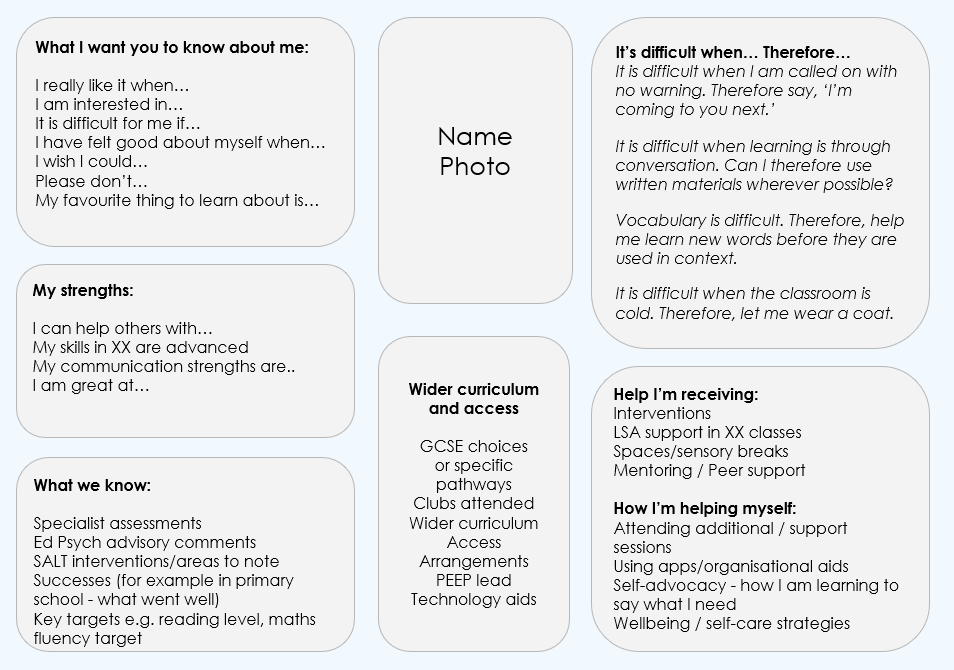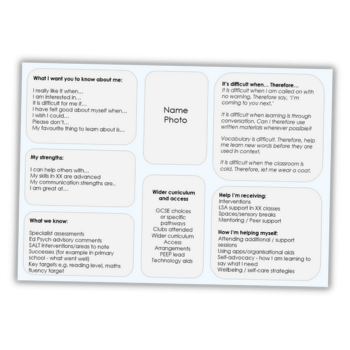Learn what a pen portrait (or student passport) is, how to co-produce an effective one and how to make sure staff implement the advice it contains effectively with this advice from Rebecca Leek…
What is a pen portrait?
A pen portrait (also known as a ‘pupil passport’) is a resource that schools have used for many years. They became more common following the introduction of the SEND Code of Practice in 2015.
Around this time, the sector was shifting its efforts towards co-production. This is the idea that all of those involved in SEND provision, and especially the young person themselves, should formulate a support plan together. This is so that final plans are done with, rather than done to.
A pen portrait is a means by which students can influence what adults know about them, in their own words.
The process of creating the pen portrait itself will involve thinking about the most useful information a young person’s teachers and support staff should know.
Example pen portrait template

Our pen portrait template, which you can download from the top of this page, includes sections that allow pupils to share personal preferences, strengths and learning needs. Key elements are:
- Personal insights: Pupils describe what they enjoy, their interests, challenges, goals and favourite learning topics. It includes prompts like:
- “I really like it when…”
- “It is difficult for me if…”
- “My favourite thing to learn about is…”
- Background information: Space for name, photo, and notes on specialist assessments, educational psychologist advisories, speech and language therapy, successes and key academic targets.
- Support and strategies: Details on the help received, like interventions, class support, sensory breaks and peer mentoring.
- Specific needs and solutions: Pupils describe situations that challenge them, with tailored recommendations to help teachers address specific needs. For example:
- “It is difficult when… Therefore…” .
- Wider curriculum: Notes on GCSE choices, extracurricular activities, access arrangements and technology aids.
- Strengths: Pupils list skills, areas of expertise and ways they contribute to helping others.
- Self-help strategies: Such as attending support sessions and using wellbeing strategies.
Benefits of a pen portrait
A pen portrait can help to oil the cogs in a busy secondary school. Co-produced carefully, their very creation will help your young people feel consulted, listened to and involved.
A pen portrait can help smooth their – and your – path through the day. Lower stress leads to more learning, making for a win-win.
No longer will students have to repeatedly advocate for themselves: ‘Please, can I have the enlarged paper copy?’; ‘May I leave five minutes early, as it takes me longer to walk to the dining room?’.
As teenagers, having to find the strength to continually ask for these reasonable adjustments is, quite frankly, not reasonable.
A good pen portrait will let their days flow more easily: ‘Here is your prepared material,’ says the maths teacher. ‘Please go to your next lesson when you’re ready,’ says the cover supervisor. Doors are opened, and difficult encounters become rarer.
Key considerations
Pen portraits are only of value if done well, so be sure to consider the following…
Has enough time been allocated for co-production?
There should be no quick ‘copy and paste’ job from last year’s pen portrait to the next. Pupil passports should be based on conversations with young people, their parents and those teachers who know them well.
Discerning and capturing what’s really useful to know – that’s where the value lies.
Are these documents ‘lit up’ for staff?
A pen portrait sat in a filing cabinet helps no one. Have you allowed enough time at the start of the year for INSET sessions? Do your heads of department talk to their teams about them?
It can be helpful to invite teachers and/or students to talk to staff about the difference a pen portrait has made for them.
Is the content properly understood?
Your school’s SENCo should be willing and available to talk staff through the more specialist wording that can be found in a pupil passport.
If a student’s document states that they have ‘interoception difficulties’ or ‘hyposensitivity relating to temperature’, what does this actually mean?
Is the information practical?
It’s all very well recording that the young person can ‘Get overwhelmed in a noisy classroom’ – but what can we actually do about that?
Provide guidance: ‘I can get overwhelmed in a noisy classroom – give me a warning if it is going to be a loud, interactive lesson, and the option of sitting outside and working in a pair or on my own.’
Rebecca Leek has been a primary and secondary teacher, SENCo. headteacher and MAT CEO; she is currently the Executive Director of the Suffolk Primary Headteacher’s Association.

Similar resources
- Developmental language disorder symptoms – Teacher resource
- Autism in girls checklist – Teacher advice and resources
- Inspirational posters – Quotes from Paralympic Games athetes
- Wonder lesson plan – Explore disability with RJ Palacio’s novel
- Introduction to Shakespeare lesson – KS3 lower-ability plan










